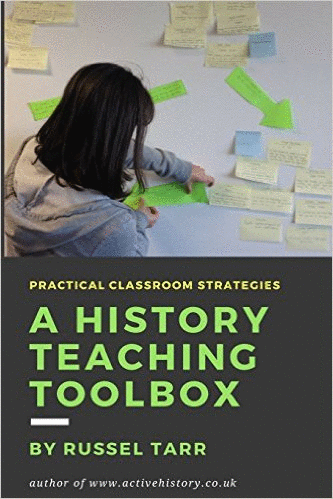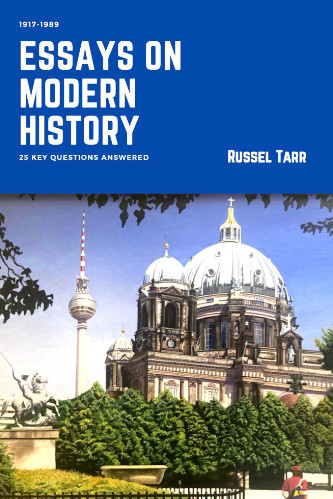World History teaching resources for the high school classroom: lesson plans, worksheets, quizzes and simulation games for KS3, IGCSE, IB and A-Level teachers.
Who was to blame for the Cold War?
Focus Points
• Why did the USA-USSR alliance begin to break down in 1945?
• How had the USSR gained control of Eastern Europe by 1948?
• How did the USA react to Soviet expansionism?
• What were the consequences of the Berlin Blockade?
• Who was the more to blame for starting the Cold War: the USA or the USSR?
Sourcework Assignment Pack |
A comprehensive pack of sources and questions in the style of GCSE/IGCSE examinations, designed to be printed off at the beginning of the unit and used as homework exercises over the course of several weeks. This pack covers the period 1945-1947. |  |
A. The Beginnings of the Cold War, 1917-1939
Although not strictly necessary, the following three resources help to put the origins of the cold war into context.
0. Starter Video: The End of World War Two
A useful starter clip to set the scene
1. Introduction: Cold War Timeline
Students start the topic with an introduction to what the Cold War was, and then they conduct their own research to produce an illustrated timeline of the main events.
2. Roots of the Cold War: Ideas (Ideological Differences)
Students complete each sentence in the table by trying to explain how capitalist / communist ideas could be defended, then produce an diagram / poster designed to illustrate the main differences between capitalism and communism.
3. Roots of the Cold War: Events (Historical Differences) [Interactive]
Students use this interactive newsfeed activity to record the main events. They then produce a "chat show" dialogue between a communist and a capitalist using the events in a timeline that is provided; each speaker will have a biased interpretation. As an extension, students produce a "living graph" using www.classtools.net.
B. Yalta, Potsdam and the Atomic Bomb, 1945
1. The Yalta Conference: Photographs as evidence
Students compare several photographs of the Big Three at Yalta, and produce a newspaper headline to accompany each one highlighting how different pictures can create sharply differing impressions.
2. The Yalta Conference: Interactive Computer Simulation! [Interactive]
An artificial intelligence simulation, complete with a worksheet: students choose whether to play as Churchill, Roosevelt or Stalin, and then pit their wits against their opponents to achieve their objectives. Complete with a worksheet, this computer lesson runs itself and is a great way of learning about the personalities, issues and results of the Yalta Conference.
3. Yalta and Potsdam: What really happened?
In this exercise, students learn about what really happened at Yalta and decide who got the most out of the conference; they then compare this to the results of the Potsdam Conference.
4. Yalta and Potsam: How similar were they?
Students answer the key question, then
the class is divided into groups representing USA, USSR, UK, Germany and Poland. Each person in the group needs to produce a biased news report about the outcomes of the two conferences.
5. The stakes are raised: The Atomic Bomb
In this lesson, students consider the ethical implications behind the bombings of Hiroshima and Nagasaki by reconstructing a scientific debate chaired by Farrington Daniels in 1945. Some excellent multimedia materials are available at the Atomic Archive.
6. End of Unit Test: The Roots of the Cold War, 1917-45 [Interactive]
A 20-Question "Fill the Gaps" exercise which gives a handy one-sided summary of the main events up to 1945. Students should be encouraged to play one of the following games prior to completing the test - either as a homework exercise, or as "last minute revision" for the first half of the test lesson in a computer lab:
Interactive quizzes on this topic [tips] |
|||
 |
 |
 |
 |
C. The Iron Curtain and Stalin's Takeover of Eastern Europe, 1946-48
1. "Iron Curtain" - Churchill's Speech at Fulton. There is also a useful video clip. There is also an interactive analysis of Churchill's Cold War Speech based at classtools.net.
2. "Salami Tactics" - Stalin's Takeover of Eastern Europe
3. The Truman Doctrine and Marshall Aid
D. The Cold War Moves to Western Europe: The Berlin Blockade (1948-49)
1. The Berlin Blockade - Interactive Newsfeed Exercise [Interactive]
Students are presented with a series of "newsfeeds" about the Berlin Blockade, which they use to complete this worksheet, and then answer a series of questions.
2. The Berlin Blockade: Timeline Challenge [Interactive]
This can be used as a follow-up from the previous exercise or (if pushed for time) an alternative. Students are presented with a series of information feeds, each one of which contains an error. Students get points for their teams if they identify the error correctly.
3a. The Berlin Blockade - 10m video documentary
3b. The Berlin Blockade - 5m video documentary
Interactive quizzes on this topic [tips] |
|||
 |
 |
 |
 |
E. The Formation of the United Nations
1. What are the functions and membership of the UN?
This worksheet encouarges students to compare the functions and membership, strengths and weaknesses of the UN with the League of Nations.
F. Section Review
1. Origins of the Cold War: Interactive Cartoon analysis [Interactive]
Analyse a series of cartoons by hovering over details and answering exam-style questions. When you have finished, the computer will provide you with a printout comparing your answer to a model answer. A great way to revise and develop sourcework skills. There is also The
Cold War to 1949: Interactive Seminar: go through the
"slides" at your own pace. Complete with activities, links and questions.
2. Origins of the Cold War: Collapsible Revision List [Interactive]
A useful "Telescopic Topic" from www.classtools.net
3. Origins of the Cold War: "Who Am I?" Challenge
Each team will be presented with a clue about a key historical figure. They get 50 points if they guess it correctly. If they wish to 'pass', they get further (easier) clues but the points available steadily decline. An incorrect guess at any point means they get zero points for that round. You can play as many rounds as you wish. It's a great way to revise!

Picture montage from Diesel Advertising Campaign, 2003. The "Big Three" did not really get on quite this well...

© 1998-2025 Russel Tarr, ActiveHistory.co.uk Limited (Reg. 6111680)
1 Torrin Drive, Shrewsbury, Shropshire, SY3 6AW, England
Privacy Policy | Contact






